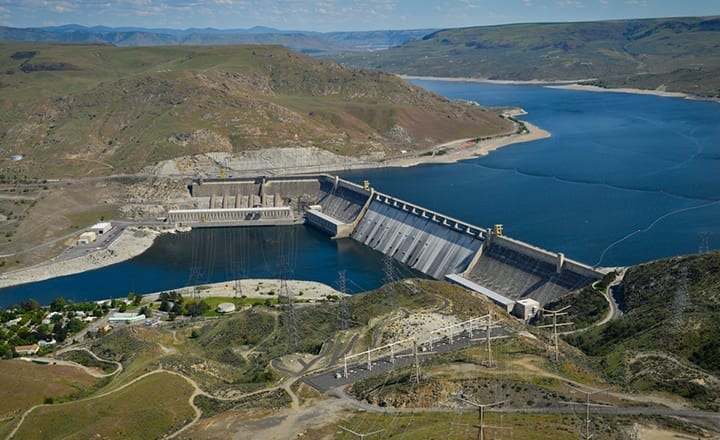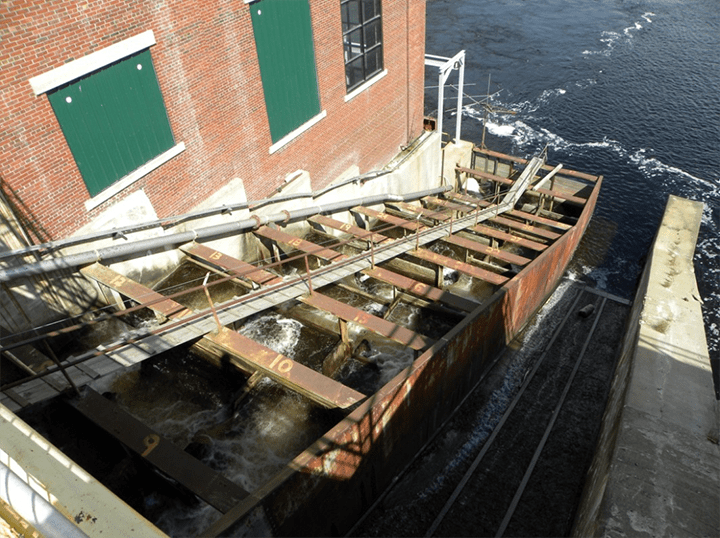5 Things You Didn’t Know About Hydropower
For many years, the National Hydropower Association has designated August 24 as National Hydropower Day in the U.S. In honor of the occasion, POWER is highlighting a variety of things many people may not know about hydropower.
1. The First Electricity Generated in the U.S. by Hydropower Was in 1880
People have been using water power to perform work for more than 2,000 years. Some of the first water wheels were used to power mills that ground wheat into flour. Long before electricity generation was contemplated, water wheels were also used to saw wood and power a variety of other equipment used in textile and manufacturing plants.
However, according to the U.S. Department of Energy (DOE), it wasn’t until 1880 that the first electricity was generated in America using hydropower. That occurred when a dynamo driven by a water turbine was used to provide arc lighting to a theater and storefront in Grand Rapids, Michigan. The following year, a dynamo connected to a turbine in a flour mill provided street lighting in Niagara Falls, New York. Both of these early power systems used direct-current technology.
The first commercial installation of an alternating-current hydropower plant in the U.S. occurred in 1893 near Redlands, California. A historical marker posted by the Institute of Electrical and Electronics Engineers to commemorate the plant, which was known as Mill Creek No. 1 Hydroelectric Plant, says it was built by the Redlands Electric Light and Power Co. and began operating on September 7 that year. “This powerhouse was foremost in the use of three-phase alternating current power for commercial application and was influential in the widespread adoption of three-phase power throughout the United States,” the plaque says.
2. Hydropower Has Consistently Generated Between 6% and 7% of Electricity in the U.S. Over the Past Decade
For much of U.S. history, hydropower has been the largest source of renewable energy. According to data reported by the U.S. Energy Information Administration (EIA), conventional hydropower generated 287,874 GWh of energy in the U.S. in 2019, which was about 6.6% of the total net generation for all sectors. Notably, that was the first year that wind power exceeded hydropower as the largest form of renewable energy.
Furthermore, the trend has continued. Wind has outperformed hydro every quarter since then. In 2022, hydropower generation dipped to 254,789 GWh, while wind energy production had ballooned to 434, 297 GWh. Meanwhile, solar generation has also grown over the years to the point where solar energy production exceeded hydropower generation in the second quarter of 2023—the first time ever in a calendar quarter. While wind and solar capacity are growing at a much faster pace than hydropower, hydro remains an important source of energy and one that is critical in balancing the intermittency of other renewables.
3. Only Two States Do Not Have Hydroelectricity Generation
EIA data from 2022 shows that every state except Delaware and Mississippi generated some electricity from conventional hydropower. Rhode Island doesn’t produce a lot of hydro—only about 7.375 GWh last year—but it has generated some hydroelectric power every year for at least the past two decades.
Washington state is the hydropower leader by a wide margin (Figure 1). More than 78,916 GWh were generated by conventional hydro in the Evergreen State in 2022. The next-highest generation total was 31,304 GWh in Oregon. New York was third with 27,432 GWh, followed by California with 17,644 GWh. Only one other state had greater than 10,000 GWh of conventional hydro generation—Alabama with 10,188 GWh.

4. Only About 3% of U.S. Dams Have Hydroelectric Generation
Most dams in the U.S. were constructed for reasons other than electricity generation. Many were designed to assist with flood control, to support irrigation systems, or to help with shipping needs, while others create reservoirs to improve wildlife habitat or for recreational purposes.
In a report prepared for the DOE by the Oak Ridge National Laboratory under the management of UT-Battelle LLC, it says about 2,500 dams in the U.S. provide power generation. The total capacity of the facilities amounts to about 78 GW of conventional hydropower and 22 GW of pumped-storage hydro.
There were estimated to be 80,000 non-powered dams (NPDs) in the U.S. when the study was conducted. The researchers said adding power generation capacity to some of the existing dams could be achieved at lower cost, with less risk, and in a shorter timeframe than new dam construction, because many of the monetary costs and environmental impacts of dam construction had already been incurred.
The report suggests adding power to NPDs has the potential to increase U.S. hydro capacity by 12 GW, which is equivalent to increasing the size of the existing conventional hydropower fleet by 15%. It says a majority of this potential is concentrated in just 100 NPDs, which could contribute about 8 GW of clean, reliable hydropower. The top 10 facilities alone could add up to 3 GW of new hydropower, according to the study.
“The abundance, cost, and environmental favorability of NPDs, combined with the reliability and predictability of hydropower, make these dams a highly attractive source for expanding the nation’s renewable energy supply,” the report says.
5. Significant Effort Is Expended to Help Fish Migrate Past Dams and Reduce Mortality
Millions of fish, including salmon, steelhead trout, shad, alewives, and sturgeon, migrate each year to spawning and rearing habitats to reproduce. Some fish swim thousands of miles through oceans and rivers to reach these freshwater destinations. However, they are often blocked along the way by human-made barriers, such as hydropower dams.
The hydropower industry works with agencies such as the National Oceanic and Atmospheric Administration (NOAA) Fisheries division, and U.S. Fish and Wildlife Service, to address fish migration issues (Figure 2). Several strategies have been developed to allow fish to move upstream past obstacles. Some examples include pool-type fish passes, Denil fish passes, nature-like bypass channels, fish lifts or locks, and collection and transportation facilities.

Downstream migration can also pose problems. Some common downstream passage technologies to exclude fish from hydro turbines include physical screens, angled bar racks, and louvers associated with surface bypasses. Other solutions, such as behavioral guidance devices that attract or repel fish using lights, sound, or electricity, have been tested, but most are still considered experimental and unproven.
A lot of research and development has been conducted to improve hydro turbine designs to limit fish mortality. The DOE has funded a number of projects over the years, including with the Electric Power Research Institute (EPRI) and others, to improve turbine designs. By some estimates, new models can lead to survival rates greater than 98%, which is much better than the 80% to 85% survival found in some older turbine designs.
Methods have also been developed to optimize existing turbines. POWER published an article last year that focused on index testing on Kaplan turbines. It explains how, with minimal cost, effort, and time, the blades of individual Kaplan turbines can be continuously adjusted to their optimal position to achieve their peak individual efficiencies, which increases the survivability of downstream migrants.
—Aaron Larson is POWER’s executive editor (@AaronL_Power, @POWERmagazine).
[Ed. note: This article was originally published in August 2020. Updates are made to the article on a regular basis.]